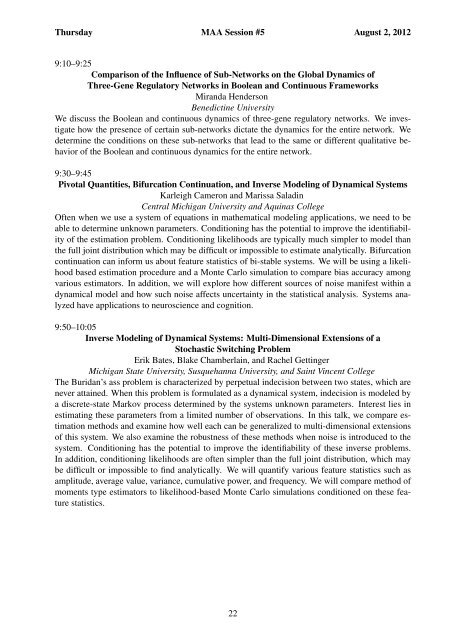Pi Mu Epsilon - Mathematical Association of America
Pi Mu Epsilon - Mathematical Association of America
Pi Mu Epsilon - Mathematical Association of America
Create successful ePaper yourself
Turn your PDF publications into a flip-book with our unique Google optimized e-Paper software.
Thursday MAA Session #5 August 2, 2012<br />
9:10–9:25<br />
Comparison <strong>of</strong> the Influence <strong>of</strong> Sub-Networks on the Global Dynamics <strong>of</strong><br />
Three-Gene Regulatory Networks in Boolean and Continuous Frameworks<br />
Miranda Henderson<br />
Benedictine University<br />
We discuss the Boolean and continuous dynamics <strong>of</strong> three-gene regulatory networks. We investigate<br />
how the presence <strong>of</strong> certain sub-networks dictate the dynamics for the entire network. We<br />
determine the conditions on these sub-networks that lead to the same or different qualitative behavior<br />
<strong>of</strong> the Boolean and continuous dynamics for the entire network.<br />
9:30–9:45<br />
<strong>Pi</strong>votal Quantities, Bifurcation Continuation, and Inverse Modeling <strong>of</strong> Dynamical Systems<br />
Karleigh Cameron and Marissa Saladin<br />
Central Michigan University and Aquinas College<br />
Often when we use a system <strong>of</strong> equations in mathematical modeling applications, we need to be<br />
able to determine unknown parameters. Conditioning has the potential to improve the identifiability<br />
<strong>of</strong> the estimation problem. Conditioning likelihoods are typically much simpler to model than<br />
the full joint distribution which may be difficult or impossible to estimate analytically. Bifurcation<br />
continuation can inform us about feature statistics <strong>of</strong> bi-stable systems. We will be using a likelihood<br />
based estimation procedure and a Monte Carlo simulation to compare bias accuracy among<br />
various estimators. In addition, we will explore how different sources <strong>of</strong> noise manifest within a<br />
dynamical model and how such noise affects uncertainty in the statistical analysis. Systems analyzed<br />
have applications to neuroscience and cognition.<br />
9:50–10:05<br />
Inverse Modeling <strong>of</strong> Dynamical Systems: <strong>Mu</strong>lti-Dimensional Extensions <strong>of</strong> a<br />
Stochastic Switching Problem<br />
Erik Bates, Blake Chamberlain, and Rachel Gettinger<br />
Michigan State University, Susquehanna University, and Saint Vincent College<br />
The Buridan’s ass problem is characterized by perpetual indecision between two states, which are<br />
never attained. When this problem is formulated as a dynamical system, indecision is modeled by<br />
a discrete-state Markov process determined by the systems unknown parameters. Interest lies in<br />
estimating these parameters from a limited number <strong>of</strong> observations. In this talk, we compare estimation<br />
methods and examine how well each can be generalized to multi-dimensional extensions<br />
<strong>of</strong> this system. We also examine the robustness <strong>of</strong> these methods when noise is introduced to the<br />
system. Conditioning has the potential to improve the identifiability <strong>of</strong> these inverse problems.<br />
In addition, conditioning likelihoods are <strong>of</strong>ten simpler than the full joint distribution, which may<br />
be difficult or impossible to find analytically. We will quantify various feature statistics such as<br />
amplitude, average value, variance, cumulative power, and frequency. We will compare method <strong>of</strong><br />
moments type estimators to likelihood-based Monte Carlo simulations conditioned on these feature<br />
statistics.<br />
22
















